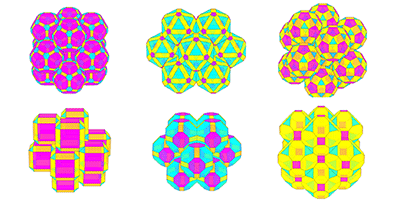March 5, 2014 report
Computational study finds maximum packing density of 55,000 different shapes

A team of researchers at the University of Michigan has used computational and analytical analysis to find the maximum packing density of 55,000 uniquely shaped particles. In their paper published in the journal Physical Review Letters, the team describes how they used two parameters: edge and corner truncation, to find the most efficient way to pack various structures.
In everyday life, packing things most efficiently is desired at the grocery store or when moving personal effects to a new home. In science, chemists or nano-scientists would like to be able to calculate the most efficient way to pack nanostructures. Unfortunately, while there obviously are known formulas for calculating the volume of a structure such as a sphere or pyramid, there is no such math that can reveal how to fit the most number of spheres or other objects into a not-so-simple structure. Currently, most who look to do so find themselves trying a large number of configurations and then choosing the one that is the most efficient—by calculating the amount of volume of empty space, or more simply via measurement such as filling a box with spheres and then measuring how much water can be poured in.
In this new effort, the researchers have not devised a formula, or even a proof, instead they have calculated the optimal packing density of a very large number of structures—the results of which can be used by researchers working with such structure shapes, such as those formed by crystals.
To find the most efficient way to pack objects into a given shape, the researchers turned to computation and analytics—they created a computer model that holds the properties of a shape, such as a dodecahedron and the objects which are to fit inside—generally identically sized spheres. Once they had models for ordinary shapes, they added two more parameters to allow for truncating the edges or corners of those shapes, thus adding nearly an infinite variety of new structures to their group of possible study shapes. That allowed them to find the most efficient way to pack objects into 55,000 different shapes.
In adjusting the parameters, the team found that their simulation also allowed them to discover patterns in the ways that changing a structure can impact packing density. They found, for example, that sometimes making small changes to corners or edges had little impact on packing density, while in other instances it had a major impact.
More information: Phys. Rev. X 4, 011024 DOI: 10.1103/PhysRevX.4.011024 . http://journals.aps.org/prx/abstract/10.1103/PhysRevX.4.011024
ABSTRACT
Packings of hard polyhedra have been studied for centuries due to their mathematical aesthetic and more recently for their applications in fields such as nanoscience, granular and colloidal matter, and biology. In all these fields, particle shape is important for structure and properties, especially upon crowding. Here, we explore packing as a function of shape. By combining simulations and analytic calculations, we study three two-parameter families of hard polyhedra and report an extensive and systematic analysis of the densest known packings of more than 55 000 convex shapes. The three families have the symmetries of triangle groups (icosahedral, octahedral, tetrahedral) and interpolate between various symmetric solids (Platonic, Archimedean, Catalan). We find optimal (maximum) packing-density surfaces that reveal unexpected richness and complexity, containing as many as 132 different structures within a single family. Our results demonstrate the importance of thinking about shape not as a static property of an object, in the context of packings, but rather as but one point in a higher-dimensional shape space whose neighbors in that space may have identical or markedly different packings. Finally, we present and interpret our packing results in a consistent and generally applicable way by proposing a method to distinguish regions of packings and classify types of transitions between them.
Journal information: Physical Review Letters , Physical Review X
© 2014 Phys.org



















